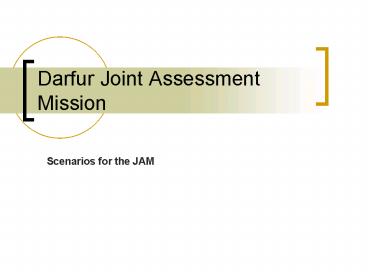Darfur Joint Assessment Mission
1 / 10
Title: Darfur Joint Assessment Mission
1
Darfur Joint Assessment Mission
- Scenarios for the JAM
2
What are scenarios?
- A scenario is a story that describes a possible
future. - Building and using scenarios can help people
explore what the future might look like and the
likely challenges of living in it. - Scenarios are intended to form a basis for
strategic conversation they are a method for
considering potential implications of and
possible responses to different events
3
Why use scenarios?
- We can use scenarios to think about the uncertain
aspects of the future that most worry us. - To discover the aspects about which we should be
concerned. - How do we react to these issues in our work?
4
How will we use scenarios?
- Scenarios for Darfur as a whole
- To be clear to everybody of what we try to do in
each scenario - To guide the Early Recovery Programme
implementation - what should happen when? - Plans A, B and C
- Scenarios for the JAM Process itself.
- Methodology
- Reach and scope of the JAM
- Security requirements
5
How would scenarios be used in the JAM Document?
- Situation A
- Large scale returns happen spontaneously in one
state - Security situation gets gradually better
- Progress made on DPA institutions
- Confidence grows over time?
- Implications for JAM
- Large scale food security programmes
- Infrastructure development
- Humanitarian support to IDPs and refugees as they
move - Reaction to the numbers, through mobilisation of
resources
6
How would scenarios be used in the JAM Document?
- Situation B
- IDPs afraid, so no significant returns
- Security situation gets progressively worse
- DPA continues to be under strain
- Some areas of Darfur could be quiet, while others
experience extensive fighting - Implications for JAM
- Heavier dependence on humanitarian aid
- Work on Rule of Law, capacity and institution
building - Limited infrastructure
- Services continue to be provided in the camps.
7
Scenarios for the JAM process
- Mixed security picture across Darfur,
fragmentation, partial implementation of the DPA,
- Collapse of security on the ground (outside state
capitals), no efforts towards reconciliation and
problem solving, DPA implementation slow or
non-existent - Formal end to the peace process
8
JAM scenario 1
- Current situation
- Poor security for Darfurians and aid groups
- Conflict on the ground in many areas
- Some good will towards peace processes
- Donor support for JAM process
- Implications for JAM process
- Strong Darfur-centered process
- Build consensus and dialogue on the ground
- Combination of key informant discussions and
field visits - Close cooperation with agencies, NGOs and civil
society - Field visits allow for a scaling up of needs
assessment for early recovery for Darfur.
9
JAM scenario 2
- A future deterioration of the situation on the
ground - Movements of nationals and internationals becomes
much reduced. - Armed groups declare no cooperation with the JAM
- Tensions between factions and movements rise
- More heavy fighting in localised areas of Darfur
- DPA continues to be seen as a possible path
towards peace / problem solving - Implications for JAM process
- Work limited to state capitals and larger towns
- Focus more heavily on key informants
- Identify work that needs to be done later to more
fully inform the Jam - Lesser focus on implementation in the coming
months.
10
Contingency Planning
- Defining the main focus or issue (political,
social, security, ethical) - Understanding situation (time, size and scope)
- Analysing hazards and risks
- Identifying, defining and prioritizing
contingencies - Developing scenarios for planning process
- Continuous updating.































